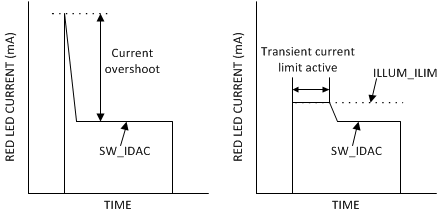JAJSRE8A October 2015 – September 2023 DLPA3000
PRODUCTION DATA
- 1
- 1 特長
- 2 アプリケーション
- 3 概要
- 4 Revision History
- 5 概要 (続き)
- 6 Pin Configuration and Functions
- 7 Specifications
-
8 Detailed Description
- 8.1 Overview
- 8.2 機能ブロック図
- 8.3
Feature Description
- 8.3.1 Supply and Monitoring
- 8.3.2 Illumination
- 8.3.3 DMD Supplies
- 8.3.4 Buck Converters
- 8.3.5 Auxiliary LDOs
- 8.3.6 Measurement System
- 8.3.7 Digital Control
- 8.4 Device Functional Modes
- 8.5 Register Maps
- 9 Application and Implementation
- 10Power Supply Recommendations
- 11Layout
- 12Device and Documentation Support
- 13Mechanical, Packaging, and Orderable Information
パッケージ・オプション
メカニカル・データ(パッケージ|ピン)
- PFD|100
サーマルパッド・メカニカル・データ
- PFD|100
発注情報
8.3.2.4.3 Transient Current Limit
Typically the forward voltages of the GREEN and BLUE diodes are close to each other (about 3 V to 5 V) however the forward voltage of the red diode is significantly lower (2 V to 4 V). This can lead to a current spike in the RED diode when the strobe controller switches from green or blue to red. This happens because VLED is initially at a higher voltage than required to drive the red diode. DLPA3000 provides transient current limiting for each switch to limit the current in the LEDs during the transition. The transient current limit value is controlled through register ILLUM_ILIM (0x02, bit [6:3]). In a typical application it is required only for the RED diode. The value for ILLUM_ILIM (0x02, bit [6:3]) should be set at least 20% higher than the DC regulation current. Register ILLUM_SW_ILIM_EN(0x02, bit [2:0]) contains three bits to select which switch employs the transient current limiting feature. The effect of the transient current limit on the LED current is shown in Figure 8-9.
 Figure 8-9 LED
Current Without (Left) and With (Right) Transient Current Limit
Figure 8-9 LED
Current Without (Left) and With (Right) Transient Current Limit